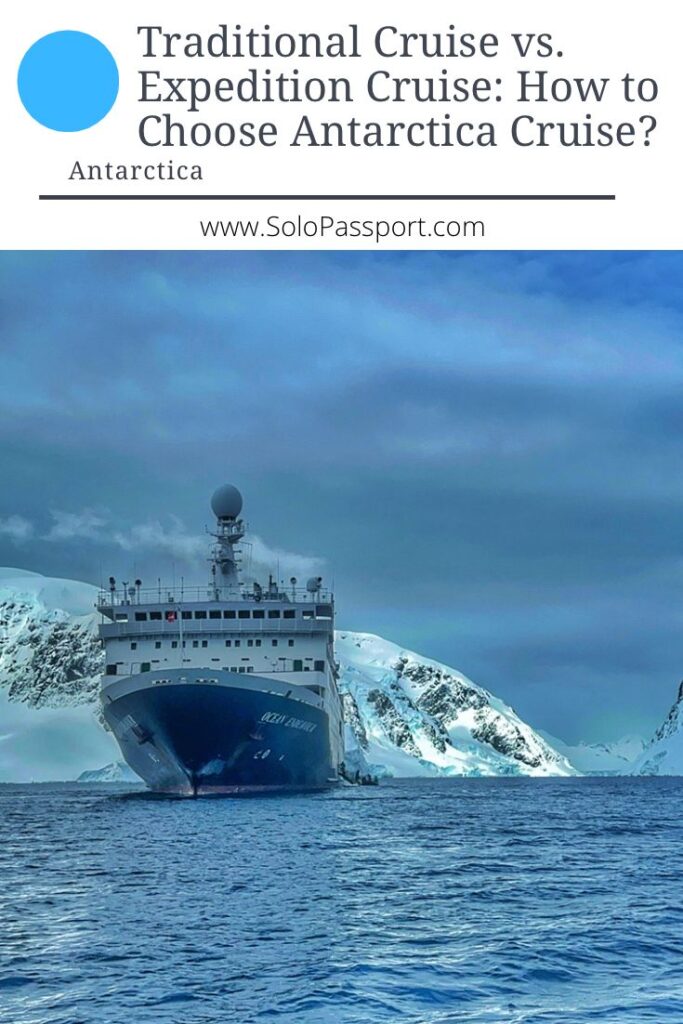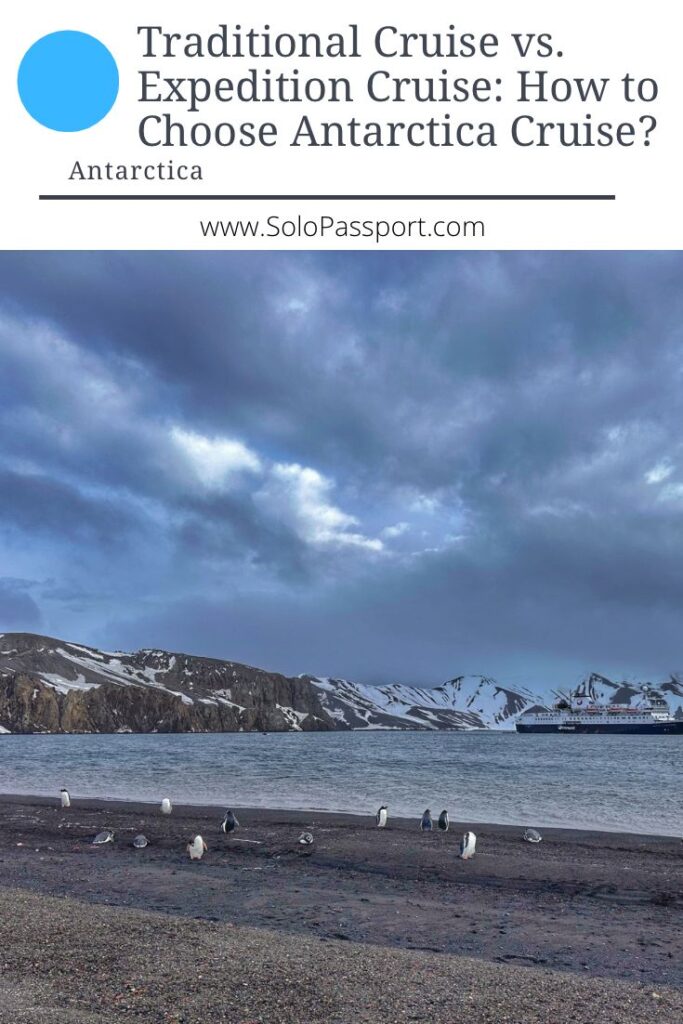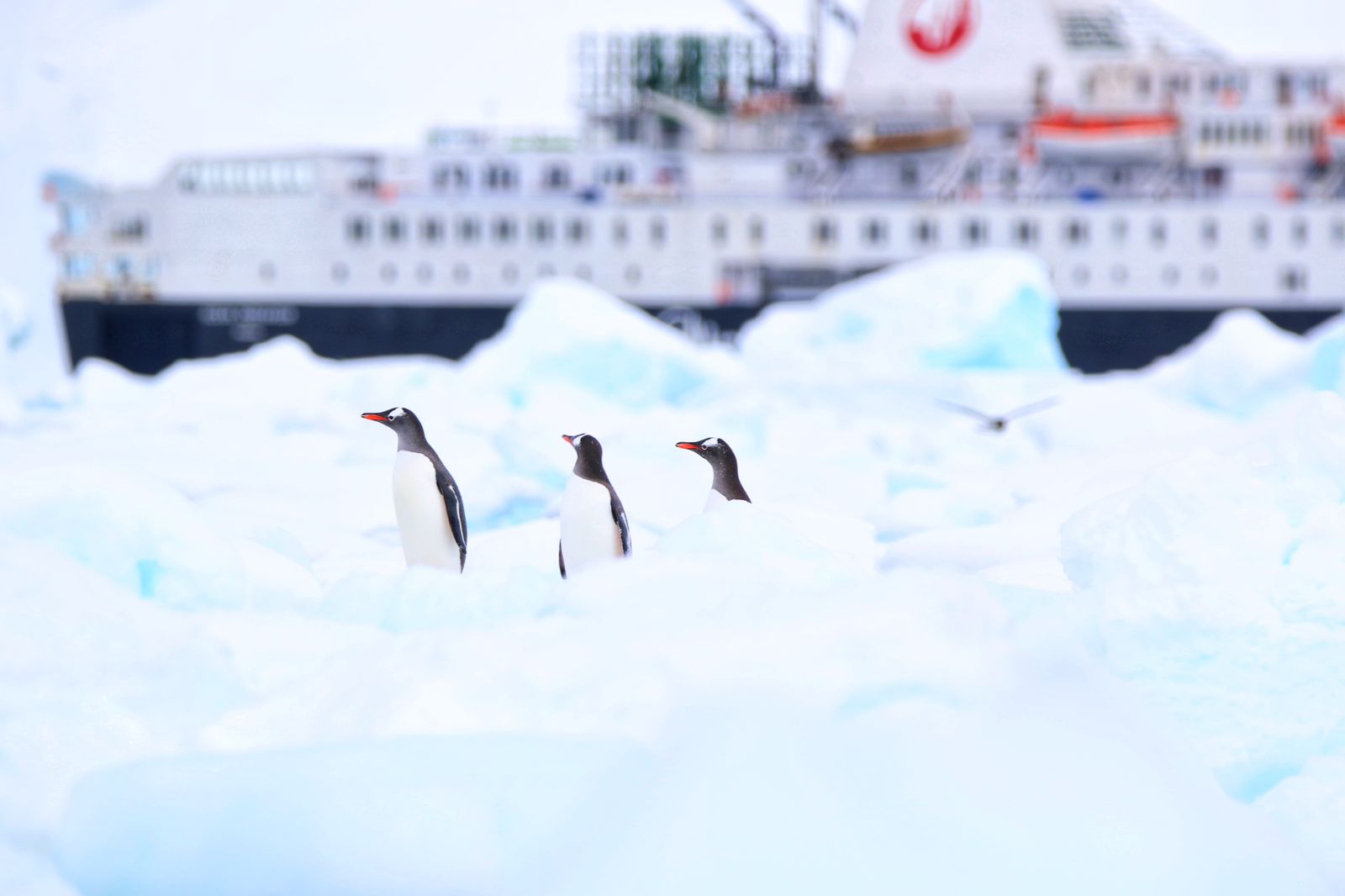Traditional Cruise vs. Expedition Cruise: How to Choose Antarctica Cruise? (2025 and 2026)
Embarking on a journey to Antarctica is a thrilling prospect, but with the many cruise options available, the decision-making process can be exciting and daunting at the same time. This guide navigates the icy waters of decision-making, providing insights into the distinctive features of traditional and expedition cruises and empowering you to make an informed decision on how to choose an Antarctica cruise.
Traditional cruises, with their grandeur and diverse onboard amenities, stand in stark contrast to the more adventurous and immersive experience offered by expedition cruises. Choosing the right cruise is a priority in ensuring a once-in-a-lifetime exploration of the southernmost continent.
This article may contain affiliate links, meaning if you decide to purchase via my links, I may earn a commission at no additional cost to you. For complete information, please see our affiliate disclaimer here.
Antarctica Travel Resources
CruiseDirect and Cruise Critic to find the best deals on cruises
Skyscanner and Trip.com for finding cheap flights
SafetyWing or WorldNomads for travel insurance. Travel insurance is mandatory when going to Antarctica.
Travel Blogs
Reasons to Visit Antarctica
22 Best Things To Do In Antarctica
Antarctica Clothing and Packing List
Antarctica Photography
Traditional Cruise vs. Expedition Cruise: How to Choose Antarctica Cruise?
How Much Does it Cost To Go To Antarctica?
5 Reasons Why Drone is Not Allowed in Antarctica
100+ Cruise Tips for Beginners to Ensure a Smooth Voyage
Page Contents
What is a Traditional Cruise?
Traditional cruises often refer to larger ships with a focus on onboard amenities, entertainment, and various dining options. However, these characteristics are not typical of Antarctic cruises due to the unique challenges presented by the harsh environment.
Click here to check for last-minute deals on Contiki
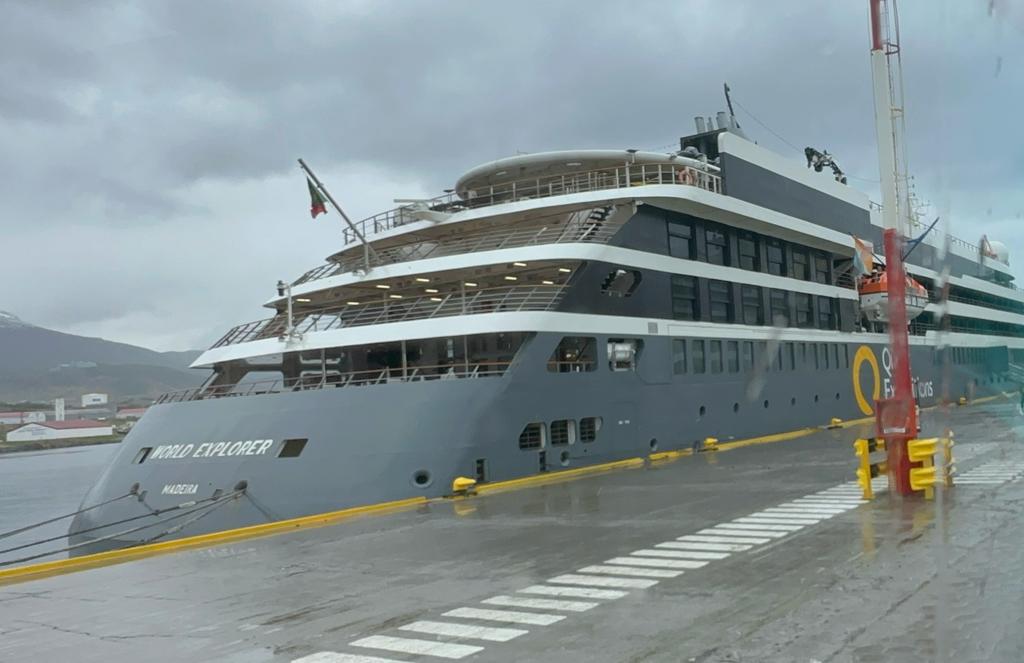
What is an Expedition Cruise?
Expedition cruises often involve smaller, ice-strengthened ships that provide an engaging experience in the unique, dramatic, and remote landscapes of the Antarctic region. These cruises typically include expert-led educational programs, talks, guided shore excursions to observe wildlife such as penguins and seals, and opportunities for activities like camping, kayaking, and Zodiac boat tours. The emphasis is on exploration, wildlife observation, and gaining a deeper knowledge of the Antarctic environment.
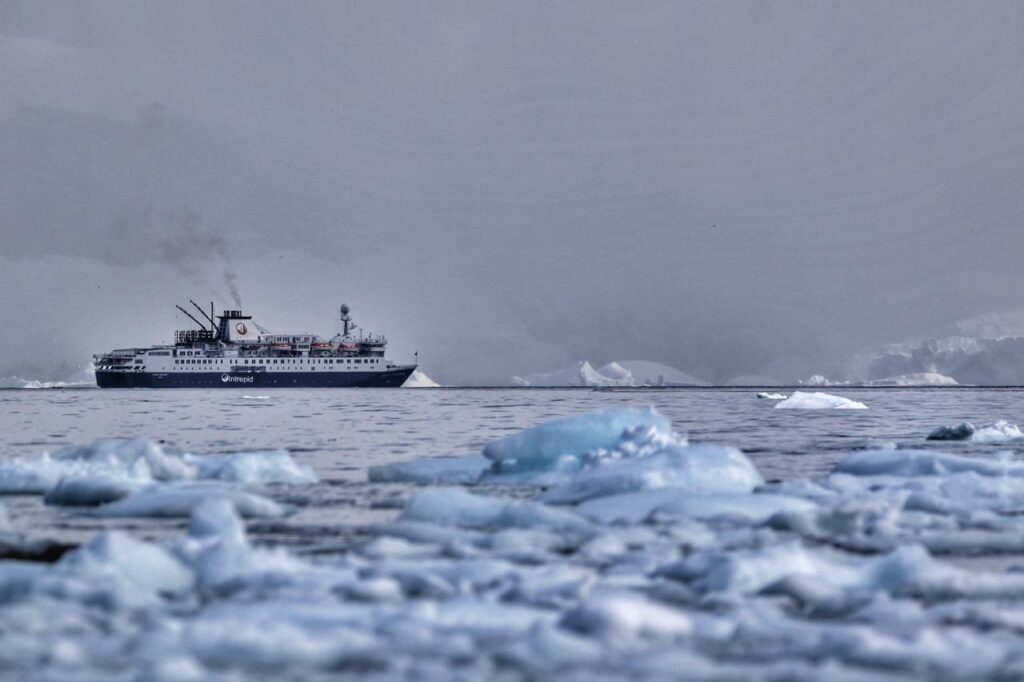
Traditional Cruise vs. Expedition Cruise at a Glance
| Traditional Cruise | Expedition Cruise | |
|---|---|---|
| Focus on Exploration | General tourist focus | Prioritise exploration, scientific learning, and wildlife encounters. |
| Ship Type | Larger Vessels | Smaller, ice-strengthened ships |
| Passenger Capacity | More passengers | Limited passengers |
| Onboard Expertise | Some commentary on region and wildlife | Naturalists, scientists, and experts on board |
| Activities | Standard shore excursions | Unique activities like camping, kayaking, and scientific lectures |
| Wildlife Observation | Includes wildlife viewing but with less emphasis on educational aspects | Emphasize close wildlife encounters and understanding ecosystems |
| Flexibility | Fixed itineraries with limited flexibility | Adapts itineraries based on weather and wildlife opportunities |
| Educational Programs | Lack of in-depth educational components | Have educational programs and workshops |
| Duration | Offer shorter trips | Involve longer journeys to reach more remote areas |
| Scientific Research | Do not involve active participation in scientific endeavors | Contributes to scientific research initiatives |
| Zodiac Cruises | May not prioritize such close-contact excursions | Use Zodiac boats for closer exploration |
| Landing Sites | Focus on more accessible, touristy landing sites | Aim for a variety of landing sites for diverse experiences |
| Photography Opportunities | Offer standard photo opportunities without specialised programs | Cater to photography enthusiasts with dedicated excursions |
| Expedition Gear | Have less emphasis on providing expedition-specific equipment | Provide specialised gear for harsh conditions |
| Cost | Have lower upfront costs but fewer inclusions | More expensive due to specialized services |
| Physical Strength Required | Requires medium physical fitness | Need good physical fitness due to expeditions |
Details of Traditional Cruise vs. Expedition Cruise
Focus on Exploration
Traditional cruises typically follow set itineraries with predetermined ports of call, emphasising popular and well-traveled shore landings and destinations. The traditional cruises offer opportunities for shore excursions, but the focus is often on leisure rather than in-depth exploration of remote or less-visited areas.
Expedition cruises prioritise itineraries based on wildlife sightings, weather conditions, and unexpected opportunities for exploration. Throughout our expedition in Antarctica, we engaged in shore excursions and daily zodiac cruises to search for penguin colonies, birds, and other wildlife.

Ship Type
The size of ships for traditional Antarctica cruises varies, ranging from medium-sized to larger expedition cruise ships.
Expedition cruises use smaller, stronger ships capable of making their way through tight spaces and accessing remote areas that larger vessels cannot reach. The Ocean Endeavor expedition cruise (the one I took) was smaller than other traditional cruises.

Passenger Capacity
Traditional cruises accommodate more passengers, around 1000 people, leading to potentially crowded excursions and less personalised exploration experiences.
Expedition cruises generally have smaller passenger capacities, allowing for a more intimate and personalised exploration experience. Our cruise had 190 passengers onboard.
Onboard Expertise
While some traditional cruises may have knowledgeable guides, the level of expertise in the areas of exploration may not match that of dedicated expedition cruises.
Expedition cruises have naturalists, research scientists, and experts onboard. There are lectures and discussions conducted every day regarding the Antarctic region, wildlife, and conservation.
Activities
Traditional cruises often feature extensive entertainment programs, including shows, and organised activities.
Expedition cruises offer a range of adventurous activities such as camping, kayaking, hiking, and Zodiac boat tours, enhancing the exploration aspect beyond traditional shore excursions.
Wildlife Observation
The focus of a traditional Antarctica cruise lies primarily in providing passengers with a scenic journey to explore the breathtaking landscapes, wildlife, and unique ecosystems of the region.
The focus of expedition cruises often includes extensive wildlife observation opportunities or workshops, with a commitment to minimal impact on the natural environment.
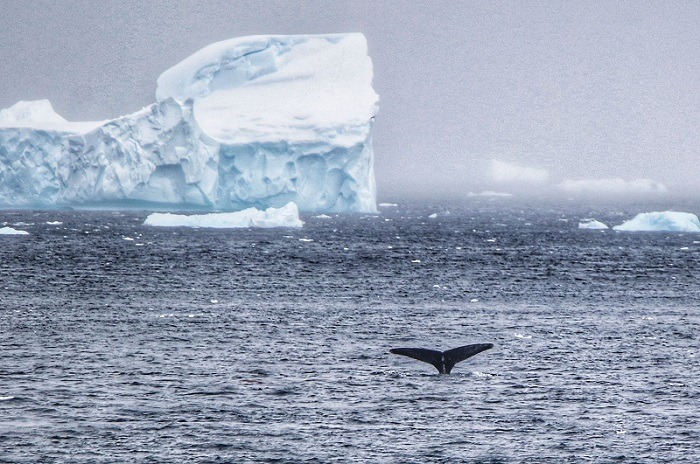
Flexibility
Traditional cruises have a fixed itinerary, which they need to follow most times.
Expedition cruises are flexible and are dependent on the weather, landing, and other factors in the area. During our expedition cruise, the plans changed almost every day due to wind and snowfall, and we had to follow according to the change.
Educational Programs
Traditional and expedition cruises offer educational programs but may differ in focus and depth. On a traditional cruise, educational activities often include informative lectures and presentations by experts, providing passengers with insights into the region’s history, geology, and wildlife. These programs aim to enhance passengers’ understanding of Antarctica’s significance.
Expedition cruises place a significant emphasis on educational programs, with expert naturalists and scientists on board, providing in-depth insights into the ecosystems and wildlife of the regions explored. These cruises often attract individuals with a keen interest in in-depth learning and a more active engagement with the environment. On our expedition cruise, we had lectures on seals, penguins, whales, and other environmental impact.
Duration
The duration of Antarctica cruises, whether traditional or expedition, can vary based on the specific itinerary and cruise provider. Generally, both traditional and expedition cruises to Antarctica can range from 10 to 21 days or more.
Traditional cruises may offer shorter durations, providing a comprehensive but condensed experience of the Antarctic Peninsula. These cruises often focus on sightseeing, wildlife observation, and exploring key landing sites.
On the other hand, expedition cruises may have longer durations, often spanning from 10 to 14 days or more. These cruises are designed for a more intimate experience, allowing passengers to explore more remote and less-visited areas, engage in additional educational and research programs, and participate in activities like kayaking or camping on the continent.
Scientific Research
Traditional cruises to Antarctica often have a primary focus on tourism, sightseeing, and wildlife observation. While some traditional cruises may include informative lectures by onboard experts, they generally don’t emphasize active scientific research participation for passengers.
Expedition cruises actively engage in or support scientific research, contributing to a deeper understanding of the regions explored. Passengers on expedition cruises have the opportunity to participate in citizen science projects, assist researchers with data collection, and gain hands-on experience in scientific endeavors. On my cruise, I was blessed to be part of the citizen science program, where we collected data and samples from fjords.

Zodiac Cruises
Traditional cruises to Antarctica often include zodiac cruises as part of their itinerary. Zodiac excursions typically provide passengers with opportunities for wildlife observation and scenic views.
Expedition cruises in Antarctica incorporate zodiac cruises as a key component of the overall experience. In expedition cruises, zodiac excursions are more exploratory, allowing passengers to access remote landing sites, research stations, and areas with a high concentration of wildlife.

Photography Opportunities
Photography opportunities in Antarctica are abundant, and both traditional and expedition cruises offer fantastic options for capturing the stunning landscapes and wildlife.
Traditional cruises provide excellent photography opportunities, allowing passengers to capture the beauty of the Antarctic Peninsula and its iconic landmarks. The focus is often on key scenic locations and wildlife hotspots accessible by ship, providing passengers with ample opportunities to take photographs from the comfort of the cruise vessel.
Expedition cruises, while also offering incredible scenery and wildlife photography, provide additional opportunities for unique shots. These cruises often include zodiac landings at more remote and less-visited locations, allowing passengers to photograph landscapes and wildlife from closer vantage points. Expedition cruises may appeal to those seeking a more hands-on and in-depth photographic adventure in Antarctica. While traveling to Antarctica, I also took an Antarctica photography workshop that allowed me to focus on photography and its techniques.
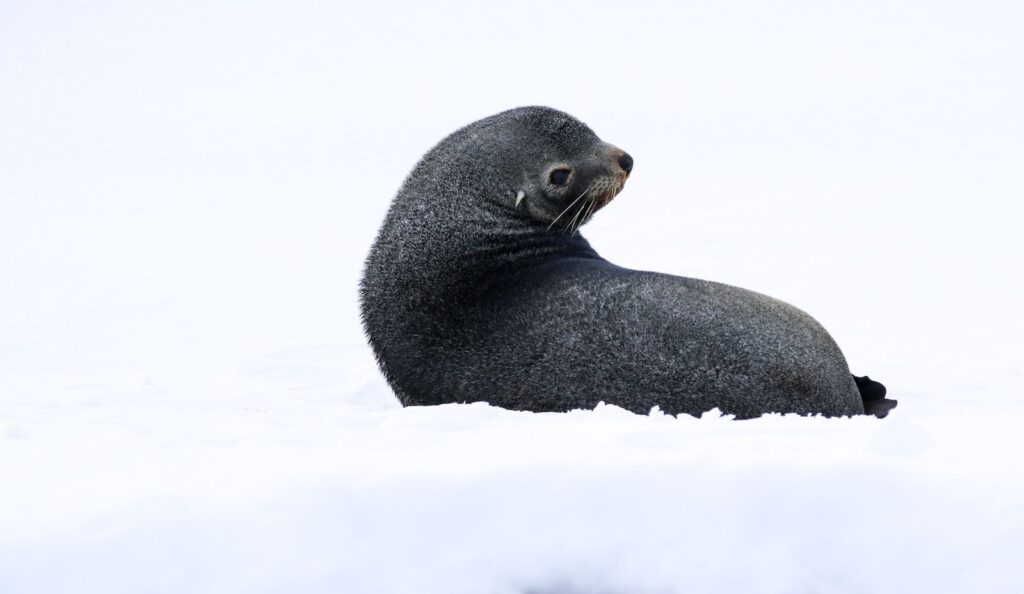
Expedition Gear
Traditional cruises often cater to a broader range of passengers, including those seeking a more comfortable and relaxed experience. Gear requirements on traditional cruises may be less extensive. The emphasis is typically on warm clothing for outdoor deck viewing and casual exploration during shore excursions.
Expedition cruises are designed for a more active and captivating experience, often involving landings at diverse and remote locations. They provide or recommend more specialised gear, such as waterproof pants, gloves, and expedition-grade boots, to ensure passengers are well-prepared for wet and cold conditions during zodiac landings. You also need to be Antarctica prepared by packing the right clothing and gear.

Cost
The cost of Antarctica cruises can vary significantly based on several factors, including the type of cruise (traditional or expedition), the cruise operator, the cruise duration, the level of luxury, and the specific amenities and activities included.
Traditional cruises to Antarctica often cater to a wider audience and vary in luxury and amenities. The cost for traditional cruises is generally lower than expedition cruises, making them a more budget-friendly option for travelers.
Expedition cruises to Antarctica are more specialised and inclusive, offering higher engagement and adventure levels. Due to the additional services, expert guides, and often longer durations with more activities, expedition cruises are more expensive than traditional cruises.
Physical Strength Required
Traditional cruises to Antarctica typically involve less physically demanding activities than expedition cruises. Shore excursions may include walking on designated paths or observation decks, and zodiac cruises for wildlife viewing are generally accessible to most passengers. Physical strength requirements for traditional cruises are usually minimal, making them suitable for different fitness levels.
Expedition cruises often provide more active and adventurous experiences, including zodiac landings, longer walks on uneven terrain, and potentially more challenging conditions. Passengers on expedition cruises may need to navigate slippery or rocky surfaces during landings and may participate in activities like excursions, kayaking, or longer walks. While a high level of physical fitness is not always required, passengers on expedition cruises should be prepared for more strenuous activities, and some operators may have specific fitness guidelines.
Regrettably, some passengers on my expedition cruise misinterpreted the nature of the journey. Despite being onboard, they opted not to participate in the zodiac boat tours, citing them as too strenuous.
How to Choose Antarctica Cruise?
Choosing the right Antarctica cruise based on your preference and likes is essential to ensure a fulfilling and memorable experience. There are some key points that can help you in choosing the right cruise:
- Travel Dates – Antarctica cruises usually operate during the summer season, between the months of November and March. Select the cruise that suits your availability and travel dates.
- Duration – Cruise itineraries and duration vary in length, ranging from shorter trips to more extended expeditions. You can determine how much time you can commit to the journey and select the duration.
- Itinerary – Review the cruise itineraries to understand the landing points, excursions, destinations, and activities offered. You can check and focus on locations that are on the itinerary.
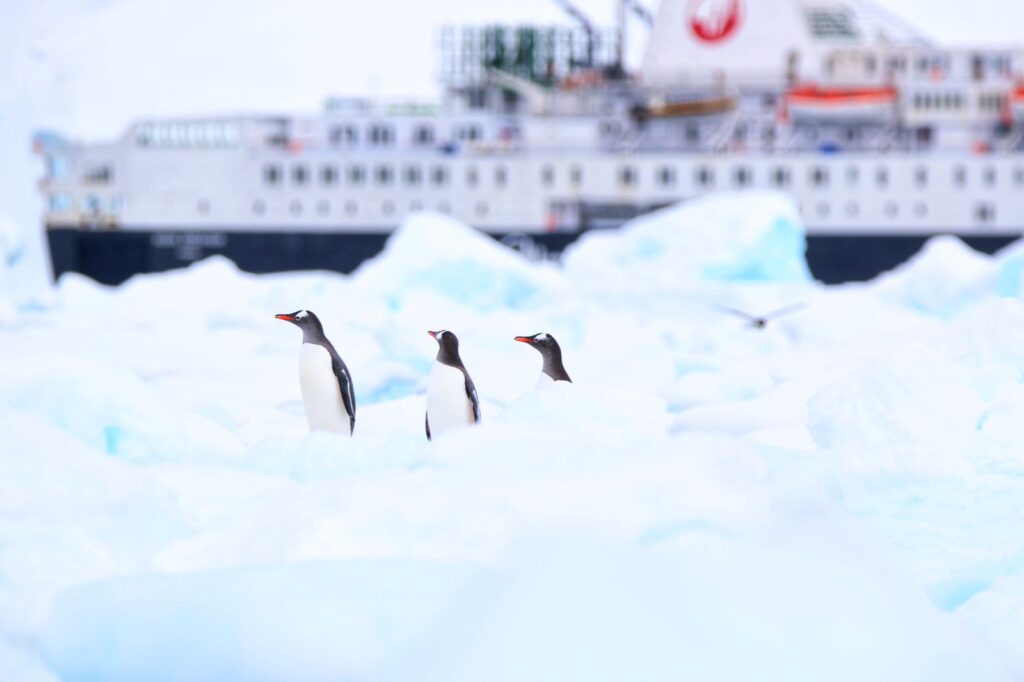
- Type of Cruise – Decide between a traditional cruise and an expedition cruise. Based on your physical fitness and endurance, you can choose to go for a more engrossing and adventurous experience or have a relaxed cruise vacation.
- Onboard Facilities – You can choose the cruise based on your preferences for onboard facilities. Usually, expedition cruises prioritise the destinations and activities, whereas traditional cruises prioritise onboard amenities such as dining and relaxation spaces.
- Safety Measures – Select a cruise operator with strict safety protocols, especially considering the challenging Antarctic conditions.
- Cost – Select the right cruise based on your budget, including the upfront cost and any additional expenses, such as excursions and equipment rentals.
- Reviews and Recommendations – Read the reviews from fellow travelers and seek recommendations. There are many social media groups that you can join to get reviews and suggestions.
- Environmental Considerations – Choose a cruise operator who is committed to environmental sustainability and responsible tourism.
Closing Notes
Ultimately, choosing between a traditional and an expedition cruise depends on your preferences and what you hope to experience in Antarctica. Both types of cruises offer unique opportunities to explore this pristine environment, so choose the one that aligns best with your interests and travel style. I hope this guide has given you enough insights to make a decision on how to choose the Antarctica cruise.
How can you support me?
You know how much I love coffee, so you can buy me a coffee – Buy me Coffee!
Or you can purchase from one of the below travel resources without any extra charge to you:
Travel Resources
Book your flight on Skyscanner.com or Trip.com
Reserve your accommodation on Stay22
Reserve your stay at a hostel on HostelWorld
Use RentalCars or DiscoverCars for hiring self-driven cars
Book your tours and travels or purchase tickets on Viator or GetYourGuide
For a universal SIM card, use DrimSim
Buy comprehensive travel insurance on SafetyWing and WorldNomads
If you liked this article and if it was helpful in your planning or travelling, do share, tweet, or pin this post.
Follow me on Instagram | Facebook | YouTube | Twitter | LinkedIn
Do you have a question? Do you want any suggestions and tips for travel, hikes, and scuba dives? Use the Subscription box below to sign up and get updates by email.
PIN for later reference | How to Choose Antarctica Cruise?
